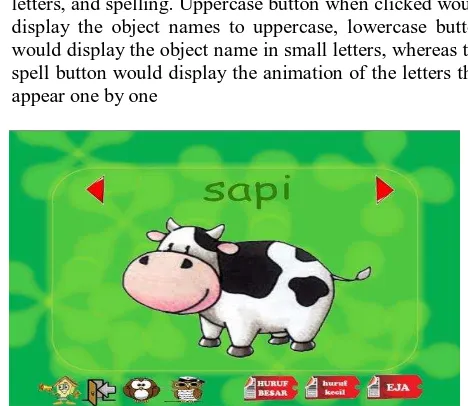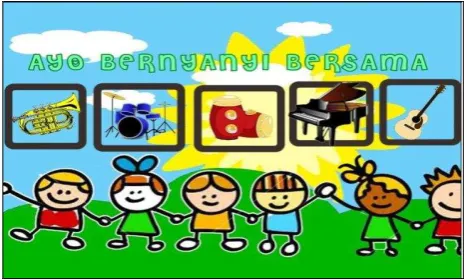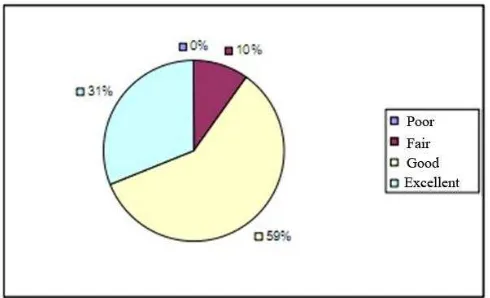Implementation of Edugame to Support Developing
Multiple Intelligence of Early Chilhood
Iwan Sonjaya
Abstract—Development of Human resource will influence the excellence of of a nation, one of aspect is the education. The education that started in early childhood will influence further age, so education of the childhood is begin in human resources. The good education should develop all kinds of aspects of intelligence, there are : Logical intelligence, Spasial intelligence,Kinetic Intelligence, intrapersonal intelligence, Interpersonal intelligence, Musical intelligence, Natural intelligence and verbal intelligence, so that will build the excelence human resources. Advance of information technology helps in developing the intelligence, that are through edugame approaching would make interesting for early childhood education. Result of this research shown is PAUD (kindergarten) which applying edugame approaching was helped in process of developing multiple intelligence to early childhood. There are result from software dan user interface aspect shown 54% respondents chose option 3 (good) and 24% chose option 4 (excelent), from the laerning process shown 59% respondents chose option 3 (good) and 31% chose option 4 (excelent), and from visual communication aspect shown 59% respondents chose option 3 (good) and 19% chose option 4 (excelent), As result generally it can be concluded help the process of development of multiple intelligence in early childhood
Keywords—Edugame,Multiple Intelligence, Early Chilhood.
I. INTRODUCTION
In education, education of the early childhood is an education which emphasize on physical and psychological development motoric coordination , intelligence (intellect, creativity, emotional intelligence, spiritual intelligence), socio-emotional (attitude and behavior as well as religious) language and communication in accordance with both the uniqueness and the developmental stages taken by early childhood. The education of Early childhood is a conscious and systematic effort, which was to influence the learners in order to develop the talent, potential, and life skills. Therefore it should be early childhood education is designed to provide as possible understanding of the early development of brain performance in early childhoo, so the interactive learning for early childhood education should be developed by utilizing a variety of media as a means of supporting learning activities, such as learning from the instructional manual to use teaching aids, such as the Interactive CD and edugame.
II. THEORITICAL BACKGROUND
A. E-Learning
UNESCO defines e-learning as learning through available in the computers. Thus, e-learning or online learning is always connected to a computer or having information available through the use of computer. Definition of E-learning is very variety that might differ from each other, but the same about the E-learning or electronic learning is learning through electronic support services
B. Interactive learning media
interactive learning media can be interpreted as a combination of various media elements that consists of text, graphics, photographs, animations, video, and voice are presented in an interactive learning in the media. Learning model as a planning or pattern that used in organizing learning materials, and a conceptual framework are describes a systematic procedure in organizing learning experiences to achieving specific learning goals [1]
C.PAUD (Early Childhood Education)
Early childhood education is the level of education before the elementary school, which is a development effort intended for children from birth to the age of six years that done by providing educational stimulation for children to have the readiness to enter further education, that was held on education formal, non-formal, and informal. According to Article 28 UU Sisdiknas No.20/2003, that range of early childhood is 0-6 years. While according to the study of early childhood education group and its implementation in several countries, early childhood education has been conducted since the age of 0-8 years[4]
D.Multiple Intelligence
Figure 1 : Gardner Multiple Intelligence[2]
III. RESEARCH METHODS AND RESULT In this research, there are following the stages:
1. Study of literature about multiple intelligence from references.
2. Design of story board,this stage covers the storyline of the step by step e-learning based on edugame are made from the beginning to end, The material is designed representing 8 types of intelligence on multiple intelligence.
3. Craeate and Collect the materials, created the materials that would be used, as an interactive media, from vector drawings, reference layouts, until teaching materials. 4. Analysis, The analysis conducted to produce a good
application, The design which good and attractive is adjusted from storyboard was created. So the application would be to be enjoyed and liked by children.
5. Integrating, this Process would be integrate several object or component multimedia was used and scripting process. 6. Testing, this activity aims to review the results of making
the application, improvements that have been made would conducted when it found “ bug” or “error” in the application.
Learning materials are based on 8 types of intelligence, so it created 9 game that is learning to read, a letter, learn colors, coloring pictures, counting, looking for a missing objects, tidy up the room, singing, and learning antonyms. Flow Chart of edugame to support developing multiple intelligence of the early chilhood shown figure 2.
A. Section Learning to Count
Material Learning to Count is an instructional material that represent the type of intelligence Mathematical Logical, for children who have a logical mathematical intelligence, it will look like on things related to numbers and if they are given a good stimulation, then his ability would maximized. This is a function of learning to learn to count in this edugame. In this section, children must answer 10 questions that begins with audio instructions, for example, should be able to count the number of fruits on shown
Figure 3 : Screenshoot Section Learning to Count
B. Section looking for the lost object
In this section, looking for a the lost object game is a learning channel of type naturalist intelligence. At this game, the user would be invited to play in the open view of the natural environment while searching for hidden animals.
Figure 4 : Screenshoot Section looking for the lost object
C. Section Learning to Read
This section is a series on learning that represents the type of verbal-linguistic intelligence. This material serves to stimulate verbal-linguistic intelligence in children by enhancing their vocabulary. In this section there are three menu buttons to learn the uppercase letters, lowercase letters, and spelling. Uppercase button when clicked would display the object names to uppercase, lowercase button would display the object name in small letters, whereas the spell button would display the animation of the letters that appear one by one
Figure 5 : Screenshoot Section Learning to Read
D. Section Learning about letter
This section is actually included in a series of learning materials to read,. At this game, the user must select the correct letter to complete the vocabulary that lost one of its letters. This game along with audio instructions and comments
Figure 6 : Screenshoot Section Learning about letter
E. Section for Learning about antonyms
Figure 7 : Screenshoot Section Learning about antonyms
F. Section Learning about color
This section provides information about the various colors. This material to function as the beginning before going into the game coloring pictures. Users asked to knew colors before they are coloring pictures.
Figure 8 : Screenshoot Section Learning about color
G. Section coloring
This section function to stimulate the visual-spatial intelligence in children, children who have this intelligence, it would be able to manipulate a shape or object and make it look nice. Stimulating method is to issue its ideas through images and graphics. in this game, the user must match the numbers on the cans of paint with numbers on the object by clicking on the number of paint cans, and then click the appropriate number on the picture
Figure 9 : Screenshoot Section Coloring
H. Section organize the room
This section function to stimulate the intellect as well as three types, namely interpersonal intelligence, intrapersonal, and motor intelligence. Children who have intrapersonal intelligence will not be easy because it is able to communicate his feelings of stress, as well as to understand himself. While the children are having fun wit motor would asked perform activities that can channel their energy. The game begins with a voice command instructions. At the time the command is executed, then the objects would move towards the last place, the user must complete the game until all is finished.
Figure 10 : Screenshoot Section organize the room
I. Section sing
This section function to sharpen the musical intelligence in early childhood. Children who have this intelligence, would happy to listen to songs, singing, and sensitivity to sound patterns.
Figure 11 : Screenshoot Section Sing
The analysis of this edugame conducted by survey research methods, determination of variables, data collection, determination of the respondent, the presentation of the data and descriptive analysis for managing data. On testing by users, there are several variables that will be observed, among others, on the aspects of software engineering, learning aspects, and aspects of visual communication[1].
Aspects of Software Engineering include usability, realibility, compability. Aspect of learning include: interactivity level, learning motivator level, the level of compatibility between learning materials and Aspect of visual communication include: Visual element, Audio, Layout.
In the software engineering aspects of most of the respondents chose good option (score 3) with a percentage of 54 %, chose fair option (score 2) with a percentage of 16 %, excellent option (score 4) with a percentage of 26 % and chose poor option (score1) with a percentage of 4%, as shown in figure 12
Figure 12 : Results of the questionnaire on aspects of software engineering
In the aspect of learning most of the respondents chose good options (score 3) with a percentage of 59 %, chose fair option (score 2) with a percentage of 10 % and excellent (score 4) with a percentage of 31%, as shown in figure 13
Figure 13 : Results of the questionnaire on aspects of learning
In the aspect of visual communication most of the respondents chose good option (score 3) with a percentage of 59%, chose fair option responses (score 2) with a percentage of 20%, chose excellent option (score 4) with a percentage of 19% and chose poor option (score of 1) with a percentage of 2%, as shown in figure 14
Figure 14 : Results of the questionnaire on aspects of visual communication
IV. CONCLUSION
Based on the questionnaire respondents to this edugame, the software engineering aspects of most of the respondents chose option number 3 (good) with a value of 54% and a response on the option number 4 (excellent) with a value of 26 %, meaning that this aspect can help in the early childhood sharpening multiple intelligence with methods of playing while learning. In the aspect of learning most of the respondents chose option number 3 (good) with a value of 59% and a response on the option number 4 (excellent) with a value of 31 %,which means that it can help children to improve the quality of learning with an approach to learn while playing. And in the aspect of visual communication most of the respondents chose option number 3 (good) with a value of 59% and a response on the option number 4 (excellent) with a value of 19 %, meaning that this aspect is helpful in giving children the value of learning as well as play.
REFERENCES
[1] Dix, Allan. Human Computer Interaction. Pearson Education Limited . Essex. 2004.
[2] Gardner,H. Frames of mind :The theory of Multiple Intelligences,Basic Books, New York, 1983
[3] Gardner,H. The Multiple Intelligences: The theory in Practice, Basic Books, New York, 1993
[4] Isjoni. Model Pembelajaran Anak Usia Dini, Penerbit alfabeta, Bandung 2009.
[5] Plant,Darrel. Smith, Dough. The LINGO Programmer’s Reference, United States of Amerika. Communications Group, 1997
![Figure 1 : Gardner Multiple Intelligence[2]](https://thumb-ap.123doks.com/thumbv2/123dok/1702776.1571403/2.595.49.556.323.698/figure-gardner-multiple-intelligence.webp)


